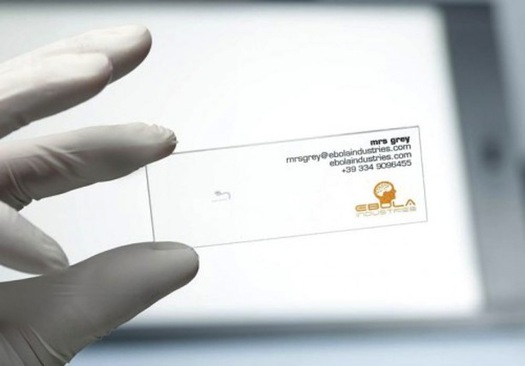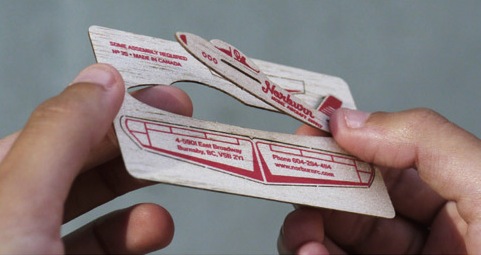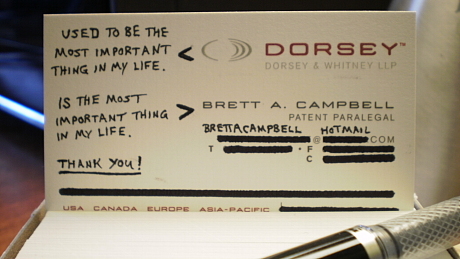
September 17, 2012
Card Tricks
The digital does not annihilate the analog. It glorifies it. Paper books and vinyl records were once quotidian; today they are objects to defend, romanticize, venerate.
Or consider this example: the humble business card. As a genre of object, it is “doomed,” one technology observer asserted not long ago, asking, “Who needs business cards when you have Google?” The function of the business card, in other words, has been replaced by a more efficient alternative: “We don’t need to be made legible to each other because we have already written ourselves onto the Internet.”
I wish I believed this. I’ve recently run out of cards and have seriously considered whether I can get away with not ordering a new set. But take a look around, and it’s not hard to find evidence of a business-card-centered creative renaissiance. In fact, start with the very object offered up as a metaphor for the business card’s pending demise: A marketing agency specializing in “viral” campaigns has one that has to be read via microscope.

Ebolaindustries’ microscope-ready “business card,” via The Atlantic
Imprint recently wrote about Sean Adams’ “three collections of high-end, limited edition business cards.” The most interesting set, called “Sad Places,” is “a series of downbeat Americana images reminiscent of Ed Ruscha’s desolate artist book photography.” Adams explained to Imprint:
I love the contradiction. Handing someone a business card is an act of optimism. It says, “Hi, this is me. I want to know you.” I love the idea of pairing this optimism and hope with the complete opposite. I love that I can hand this to someone and they will look at it and smile, say “thanks,” then turn it over and look at me puzzled. That’s making an impact, which is a business card’s job.

Sean Adams “Sad Places” business cards, via Imprint.
Yes. Try communicating that with a LinkedIn request.
And this is part of the point. First, the digital glorifies such physical stuff by making its physicality more special. A Wall Street Journal article last year about “calling card” trends maintained that “a personalized card acts as a quiet rebuttal to the white noise jabber-jawing of Twitter and Facebook.”
But second, this very impulse inspires drastic innovation precisely by means of raising the bar on what it takes to stand out as an analog thing. This is why I not only will probably need to get more business cards, but the pressure is on to make them really interesting, creative, memorable, remarkable, keep-able — something that deserves to exist.
More examples:

Business card as bike tool, via Make/Craft’s blog

Concrete business card, via PSFK

Hand-stained, laser-cut cards, one of several examples of wooden cards noted by Core77

Ritornell’s cards play music through a special music box, as described on Create Digital Music

A card that can be reassembled into a toy plane, via Book of Joe
Designer Silvio Teixeira made a poster to be cut into 100 business cards, functioning as a flipbook. Via Wired Design.
Dipping into Design Observer’s archives, there are two more card-uses worth mentioning. Jessica Helfand pointed out these MausethDesign “None of Your Busines Cards,” which turn out to include “fake names and numbers, and a special hidden message: never call me again.”

MausethDesign None of Your Busines Cards
And Ernest Beck, writing in Change Observer, noted a fascinating project called Cards of Change: “Upload your old business card with an added message about yourself that is upbeat or inspiring or insightful, to you or others.”
That last example depends on the Web, of course, and several of the above take advantage of new technology. More to the point, you’re looking at all these examples on the Web, or through a mobile app.
There’s a good reason that the digital savants of Buzzfeed have just launched a “vertical” devoted to “everything old.” Analog stuff is popular online. This brings us to the third way that the digital glorifies the analog: through the near-magic, spreadable, frictionless means of digital seeing. Come up with a suitably compelling physical object, and it just might transcend the analog world and “go viral” in the digital one.
These two worlds do not exist in opposition. They are intertwined, in ways we are still figuring out.
The question of which one is more accurately characterized as “real,” I will leave for you to decide.
Observed
View all
Observed
By Rob Walker
Related Posts

Equity Observer
L’Oreal Thompson Payton|Essays
‘Misogynoir is a distraction’: Moya Bailey on why Kamala Harris (or any U.S. president) is not going to save us

Equity Observer
Ellen McGirt|Essays
I’m looking for a dad in finance

She the People
Aimee Allison|Audio
She the People with Aimee Allison, a new podcast from Design Observer

Equity Observer
Kevin Bethune|Essays
Oh My, AI
Related Posts

Equity Observer
L’Oreal Thompson Payton|Essays
‘Misogynoir is a distraction’: Moya Bailey on why Kamala Harris (or any U.S. president) is not going to save us

Equity Observer
Ellen McGirt|Essays
I’m looking for a dad in finance

She the People
Aimee Allison|Audio
She the People with Aimee Allison, a new podcast from Design Observer

Equity Observer
Kevin Bethune|Essays


 Rob Walker is a technology/culture columnist for
Rob Walker is a technology/culture columnist for